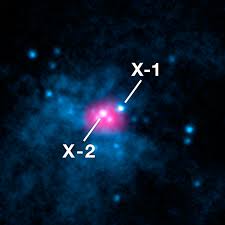Overview
Astronomers have discovered many high-energy objects in the sky that give off X-rays. Since the atmosphere blocks most X-rays from reaching observatories on Earth, astronomers have used telescopes from high-altitude balloons, rockets, and satellites to observe thousands of sources.
X-Ray Sources
X rays are part of the electromagnetic spectrum in high energy ranges beyond visible light and ultraviolet light. Their wavelength is between 0.01 and 10 nanometers. Extremely hot gases in the range of 1 million Kelvin to hundreds of millions Kelvin are thought to produce X-rays. In order to produce hot plasma, gases are heated in extremely strong gravitational fields. White dwarfs, neutron stars, and other dense objects yield an energy output 100,000 times greater than that from the Sun.
X-Ray Detection
The atmosphere blocks most X-rays from astronomical sources from reaching Earth. Some of the earliest discoveries of X-ray sources were conducted from telescopes mounted in high-altitude balloons. X-rays from the Crab Nebula were discovered from detectors on a flight in 1964. The Crab Nebula, an item in the constellation Taurus, had been studied for centuries with optical and radio telescopes. It is thought to be a remnant of a supernova explosion. The neutron star at the center of the nebula consists of compressed gas about 28-30 km across, spinning at a rapid rate. It emits pulses of energy from radio waves, and visible light to X-rays and gamma rays.
X-Ray Observations
X-ray telescopes have also been carried aboard sounding rockets to higher altitudes. In 1962, one of the strongest X-ray sources was discovered by accident. Scorpius X-1 consists of a neutron star and its binary companion. The higher gravity from the neutron star collects matter from the companion as it orbits, and those gases are heated by the gravitational fields to a high enough temperature to produce X-rays.
X-Ray Satellites
Although many of the strongest X-ray sources were observed from telescopes mounted on high-altitude balloons or sounding rockets, those observations were relatively brief and did not cover the full range of X-rays. Telescopes and other detectors specifically for X-rays were mounted on satellites. The Chandra satellite observatory has been in continuous operation since it was launched in 1999. It is able to observe very faint, distant sources, as well as brighter objects not visible through the atmosphere. Many neutron stars are strong sources of X-rays, as are gases spiraling into black holes in the centers of galaxies.
Interested in science tutoring services? Learn more about how we are assisting thousands of students each academic year.
SchoolTutoring Academy is the premier educational services company for K-12 and college students. We offer tutoring programs for students in K-12, AP classes, and college. To learn more about how we help parents and students in Silver City, NM: visit Tutoring in Silver City, NM




